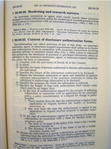Where You Have Been

The average student spends
in importance for exam preparation
1.7
How to Read a Statute
-
Segment ProgressBar

INTRODUCTION
Most publications that publish statutes provide research tools and comments about the statute. These research tools and comments are, quite often, much longer than the actual statute. But before you use those tools, you must first find the actual statute.
The Layout of Statutes
Locating and utilizing published statutes means using the research tools provided by the publisher. As you are introduced to legal research, you will become familiar with both the statutes themselves and the research tools associated with them.
In the below example, note the actual statue. It is at the top. Notice that it is very short. This is actually typical. Statutes are not usually very long, individually. After the title, you will see the statute, followed by a research tool that can lead to additional authority. (In that statute, it is an "Editor's Note.")

ViewPoint
Click here to see an example of a Statute.
Paralegal Persepctive . . .
READING STATUTES
The most surprising aspect when I first started looking up statutes is how short each statute usually was. Most of the books are filled with research sources that relate to the statute. For instance, a typical federal statute (found in the United States Code) may be less than a page long. But there may be hundreds of pages of research references following the statute, such as citations to cases that have ruled on the applicability of the statute. Oh, one more thing: attorneys often refer to statutes as 'code' or 'rule,' even when they aren't titled that. For instance, an attorney might say 'We need to find the rule on this.' Or, 'Is this covered by code?' So get used to these interchangeable references:
Statues. Rules. Codes.
Lecture Notes . . .
How to Read Statues
Let's make a couple of additional points.
Research Tools
Research Tools usually follow the statute. They provide references to authorities such as cases that have actually cited that particular statute, but they also may refer to regulations related to the statute, other statutes, or additional relevant authority.
Statute History
The history, while not usually used, can help if your client was charged or sued for violation of a statute that has changed since the offense was committed.
